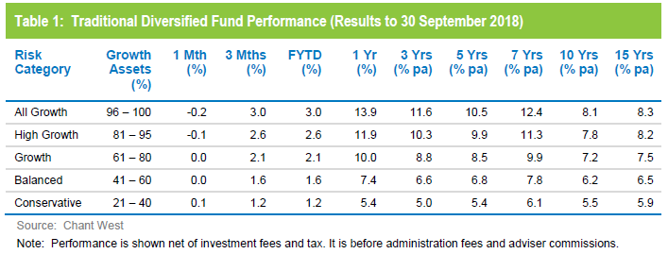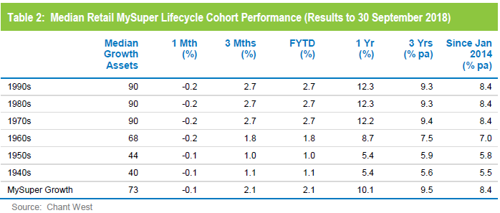Super funds got off to a solid start to the 2018/19 financial year, with the median growth fund (61 to 80% in growth assets) returning 2.1% for the September quarter. However, the first half of October has seen a change of fortunes. Share market jitters, triggered by rising US interest rates and the escalating US/China trade war, have driven the median growth fund about 2.3% lower so far this month.
Over the September quarter, share markets around the world gained ground. Australian shares were up 1.5%, while international shares gained 5.4% in hedged terms and an even more impressive 7.4% in unhedged terms, resulting from the decline in the Australian dollar from US$0.74 to US$0.72. Listed property also had a solid quarter with Australian and international REITs gaining 2% and 0.3%, respectively.
Chant West senior investment research manager Mano Mohankumar says: “While the September quarter was solid, early October has brought corrections in domestic and global share markets. These falls don’t come as a surprise as investment markets have had such a strong run over the past nine years, so most asset sectors were fully valued or close to it.
“It’s at times like this that the benefits of diversification are most evident. Growth fund performance isn’t driven by listed share and property markets alone. On average, growth funds have about 55% invested in those markets so that leaves a substantial 45% allocated across a wide range of other sectors, including unlisted assets such as infrastructure and property as well as traditional defensive sectors like bonds and cash. This helps cushion the blow when there are sharp market falls like those we’ve seen this month. So while Australian shares and hedged international shares are down 5.4% and 4.2%, respectively, in October so far, we estimate that the median growth fund is only down 2.3%.
“How fund members react to the negative headlines is important. Older people approaching retirement are naturally more likely to be concerned about seeing their balances go down than people in their 20s or 30s. However, they also tend to be more conservatively invested. We estimate that conservative funds (21 to 40% in growth assets) are only down 0.9% over October to date.
“We encourage members to check that the investment option they’re in is suitable for them and, if so, to remain patient, think long-term and not get distracted by short-term volatility. Trying to time the market by moving into a more conservative option can be detrimental because not only do you crystallise your losses, but you also risk missing out on the subsequent rebound when markets recover.”
Table 1 compares the median performance for each of the traditional diversified risk categories in Chant West’s Multi-Manager Survey, ranging from All Growth to Conservative. Having recovered from the GFC, all risk categories are now ahead of their long-term return objectives over one, three, five, seven, 10 and 15 years.

Most retail fund default members now in lifecycle products
Mohankumar says, “While our Growth category is still where most people have their super, a meaningful number are now in so-called ‘lifecycle’ products. Most retail funds have adopted a lifecycle design for their MySuper defaults, where members are allocated to an age-based option that is progressively de-risked as that cohort gets older.”
“It’s difficult to make direct comparisons of the performance of these age-based options with the traditional options that are based on a single risk category, and for that reason we report them separately. Table 2 shows the median performance for each of the retail age cohorts, together with their current median allocation to growth assets.”

While lifecycle is the most common MySuper default in the retail sector, most not-for-profit funds still use their traditional Growth options for that default role but a few have also gone down the lifecycle path. While the general premise is the same, in the not-for-profit model members ‘switch’ from one traditional risk category to another at particular ages. The diversified options that underlie these products are included in Table 1.
To illustrate the early results of the lifecycle model, Table 2 includes a row for these traditional MySuper Growth options – mainly, but not all, not-for-profit funds. Caution should be taken when comparing the performance of the retail lifecycle cohorts with the median MySuper Growth option as they are managed differently so the level of risk varies.
The past few years have seen strong performance from growth assets so, as you would expect, the options that have higher allocations to growth assets have done best. Since MySuper began in January 2014 younger members of retail lifecycle products – those born in the 1970s, 1980s and 1990s – have held their own compared with the median MySuper Growth fund, but have done so by taking on more equity market risk.
Older members – those born in the 1960s or earlier – have underperformed traditional MySuper Growth options by some margin because these older cohorts have taken on less risk. This is because capital preservation becomes more important at those ages so, while they miss out on the full benefit of rising markets, older members in retail lifecycle options are better protected in the event of a market downturn.
Long-term performance remains above target
MySuper products have been operating for less than five years, so when considering performance it is important to remember that super is a much longer-term proposition. The Chart below compares the performance since July 1992 – the start of compulsory superannuation – of the traditional Growth category median with the typical return objective for that category (CPI plus 3.5% per annum after investment fees and tax over rolling five-year periods). The healthy returns in recent years have seen the five year performance tracking well above that CPI plus 3.5% target for the past five years.




